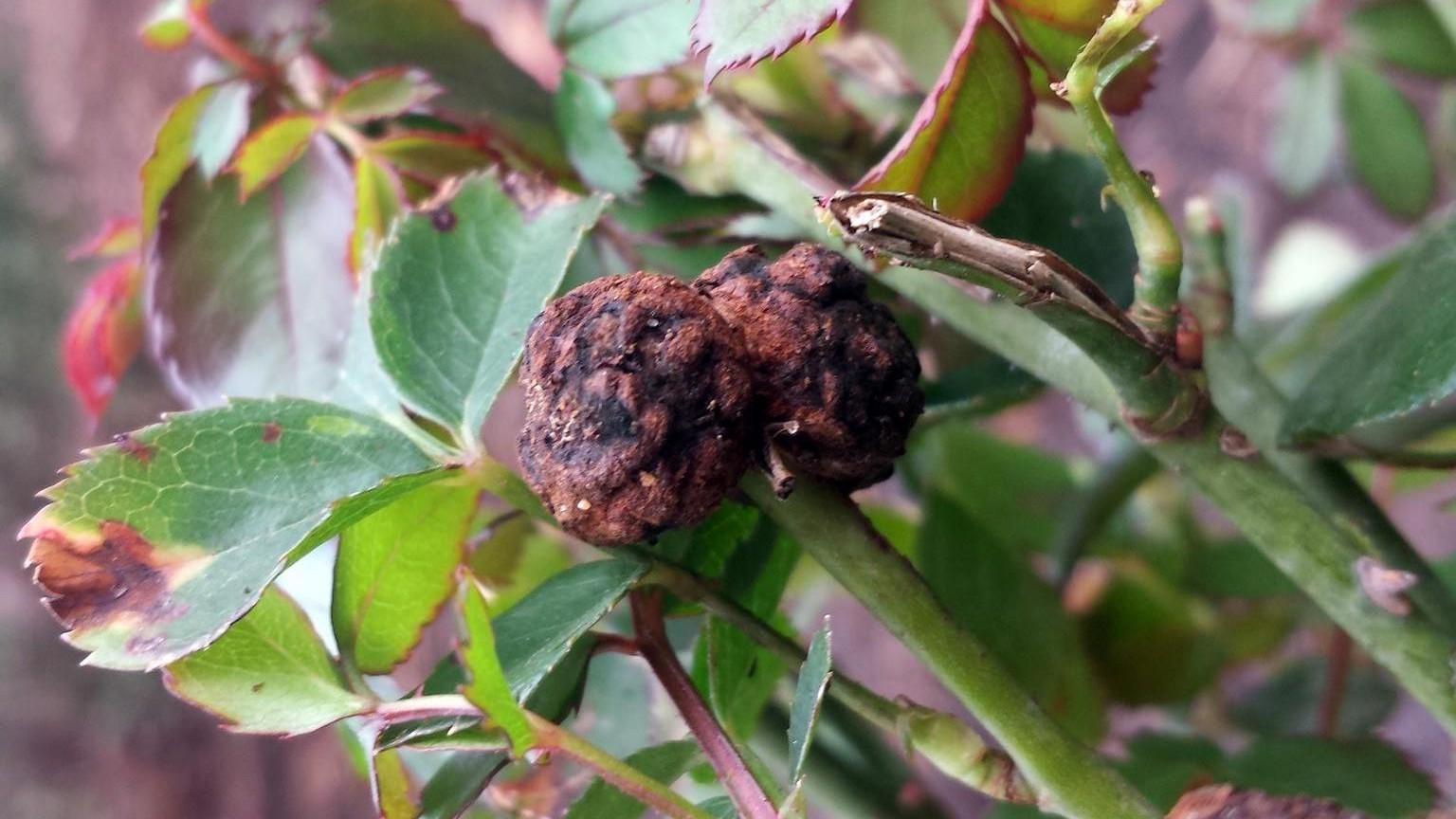Crown gall is caused by a soil-inhabiting bacterium, Agrobacterium tumefaciens, which occurs worldwide and attacks over 600 plant species in more than 90 plant families. The disease severity can vary depending on the host, but host mortality is usually caused by secondary pathogen invasion. Infected plants are also predisposed to drought and winter injury. Other growths caused by insects, adventitious growths, tissue proliferation and burls can sometimes be mistaken for crown gall symptoms.

The most obvious symptoms are the galls or growths that usually occur on the twigs, stems, and roots near the base of the plant at the soil line. Gall size can vary from small to large and are usually spongy when young, but then become hard and woody with age. Galls can also appear higher in the plant canopy, on twigs and branches, well above the soil line. The color of galls will vary from cream or green on young roots and stems, to normal bark color on older stems and roots. The outer tissue on older galls will often crack, become rough, and will frequently slough off. Plants that are infected late in the growing season may not show symptoms until the next season.
Crown gall bacteria can be present in soil, on contaminated tools or carried by water to susceptible host plants. These bacteria can also survive in contaminated soil for years without a susceptible host. Crown gall bacteria need fresh wounds to cause an infection, which can be caused by transplanting and cultivating activities, feeding damage from nematodes or soil insects. Galls form within 2-4 weeks after infection on actively growing plants. As outer surfaces of the galls slough off, bacteria are returned to the soil.
Management
Removal of galls will not cure infected plants because bacterial genes already inserted into the host's cells will continue to transform additional cells throughout the plant and produce galls in other locations. Removal of infected plants will lower bacterial populations in the soil, however low populations of soil bacteria still persist as surface colonies on many plant species regardless of their susceptibility to crown gall. Exclusion of infected plants by inspection of all nursery stock prior to planting is critical to prevent the introduction into new planting beds. However, late infections on dormant nursery stock may not always show obvious symptoms. If crown gall symptoms are already present on existing plants consider the selection of other nonsusceptible plant material.
 English
English العربية
العربية Български
Български 简体中文
简体中文 繁體中文
繁體中文 Hrvatski
Hrvatski Čeština
Čeština Dansk
Dansk Nederlands
Nederlands Suomi
Suomi Français
Français Deutsch
Deutsch Ελληνικά
Ελληνικά हिन्दी
हिन्दी Italiano
Italiano 日本語
日本語 한국어
한국어 Norsk bokmål
Norsk bokmål Polski
Polski Português
Português Română
Română Русский
Русский Español
Español Svenska
Svenska Català
Català Filipino
Filipino עִבְרִית
עִבְרִית Bahasa Indonesia
Bahasa Indonesia Latviešu valoda
Latviešu valoda Lietuvių kalba
Lietuvių kalba Српски језик
Српски језик Slovenčina
Slovenčina Slovenščina
Slovenščina Українська
Українська Tiếng Việt
Tiếng Việt Shqip
Shqip Eesti
Eesti Galego
Galego Magyar
Magyar Maltese
Maltese ไทย
ไทย Türkçe
Türkçe فارسی
فارسی Afrikaans
Afrikaans Bahasa Melayu
Bahasa Melayu Kiswahili
Kiswahili Gaeilge
Gaeilge Cymraeg
Cymraeg Беларуская мова
Беларуская мова Íslenska
Íslenska Македонски јазик
Македонски јазик יידיש
יידיש Հայերեն
Հայերեն Azərbaycan dili
Azərbaycan dili Euskara
Euskara ქართული
ქართული Kreyol ayisyen
Kreyol ayisyen اردو
اردو বাংলা
বাংলা Bosanski
Bosanski Cebuano
Cebuano Esperanto
Esperanto ગુજરાતી
ગુજરાતી Harshen Hausa
Harshen Hausa Hmong
Hmong Igbo
Igbo Basa Jawa
Basa Jawa ಕನ್ನಡ
ಕನ್ನಡ ភាសាខ្មែរ
ភាសាខ្មែរ ພາສາລາວ
ພາສາລາວ Latin
Latin Te Reo Māori
Te Reo Māori मराठी
मराठी Монгол
Монгол नेपाली
नेपाली ਪੰਜਾਬੀ
ਪੰਜਾਬੀ Afsoomaali
Afsoomaali தமிழ்
தமிழ் తెలుగు
తెలుగు Yorùbá
Yorùbá Zulu
Zulu ဗမာစာ
ဗမာစာ Chichewa
Chichewa Қазақ тілі
Қазақ тілі Malagasy
Malagasy മലയാളം
മലയാളം සිංහල
සිංහල Sesotho
Sesotho Basa Sunda
Basa Sunda Тоҷикӣ
Тоҷикӣ O‘zbekcha
O‘zbekcha አማርኛ
አማርኛ Corsu
Corsu Ōlelo Hawaiʻi
Ōlelo Hawaiʻi كوردی
كوردی Кыргызча
Кыргызча Lëtzebuergesch
Lëtzebuergesch پښتو
پښتو Samoan
Samoan Gàidhlig
Gàidhlig Shona
Shona سنڌي
سنڌي Frysk
Frysk isiXhosa
isiXhosa